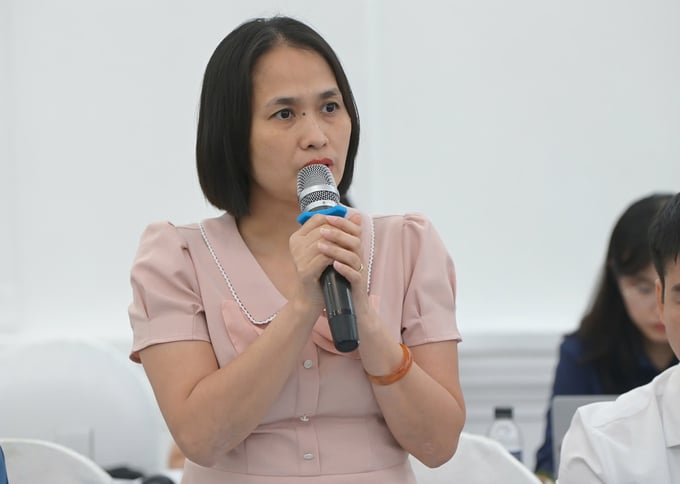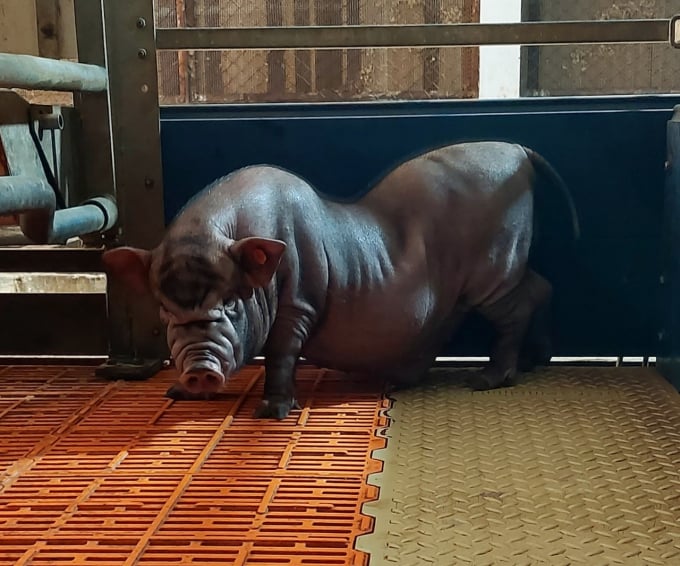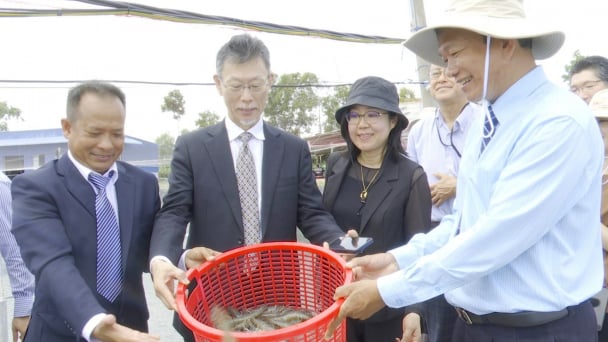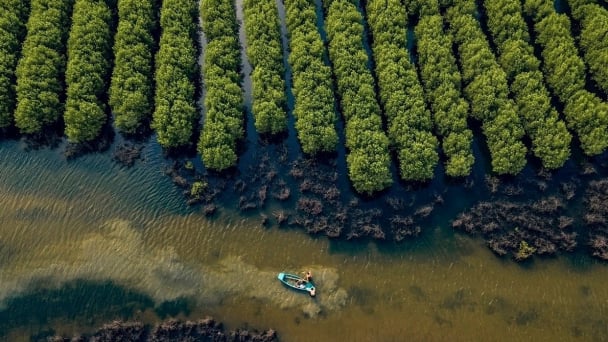June 17, 2025 | 04:39 GMT +7
June 17, 2025 | 04:39 GMT +7
Hotline: 0913.378.918
June 17, 2025 | 04:39 GMT +7
Hotline: 0913.378.918

Dr. Nguyen Khanh Van, Lead of Animal Cell Technology Laboratory (Institute of Animal Husbandry). Photo: Tung Dinh.
According to Dr. Nguyen Khanh Van, Head of the Animal Cell Biotechnology Laboratory at the Institute of Animal Husbandry, biotechnology is a rapidly evolving field with wide-ranging applications across industries such as agriculture, food, and pharmaceuticals.
"In the livestock industry, in particular, biotechnology has created groundbreaking advancements, enhancing breed quality, preserving rare species, and contributing to the sustainable development of the sector," Dr. Van shared.
In Vietnam, the application of biotechnology in livestock production has achieved significant milestones, from improving livestock productivity to preserving valuable genetic resources.
One notable application of biotechnology in livestock farming is artificial insemination technology. This technique provides breeders access to high-quality sperm from both domestic and international sources.
Artificial insemination optimizes reproductive efficiency, improves productivity and livestock quality, and significantly curtails the spread of reproductive diseases. It also reduces the costs associated with maintaining male breeders and enhances overall economic efficiency.
Vietnam has achieved notable successes in applying artificial insemination to large livestock such as buffalo and cattle, as well as to aquatic poultry like geese and ducks. For example, the Dai Xuyen Duck Research Center has developed a hybrid duck-goose breed using artificial insemination, which has resulted in faster growth rates, lower feed consumption, and superior meat quality.
Reproductive technology extends beyond artificial insemination to include advanced techniques such as ovulation induction and embryo transfer. These technologies facilitate rapid breeding from high genetic-value stock, especially in single-birth livestock like buffalo, cows, and goats.
In the dairy industry, ovulation induction and embryo transfer have contributed significantly to the breeding of high-yielding dairy cows, enhancing fertility and disease resistance, and thereby improving milk production efficiency. In 1994, the Institute of Animal Husbandry announced the creation of calves using the technique of multiple ovulation induction and embryo transfer. Since then, the Institute's technical staff have successfully bred numerous valuable calves using this method.
However, in Vietnam, the application of ovulation induction and embryo transfer has yet to reach its full potential due to several challenges, including insufficient investment in technology and the lack of highly skilled human resources. These techniques demand well-trained professionals and modern infrastructure, which many livestock farms have not yet been able to provide.
Beyond increasing productivity, biotechnology also plays a vital role in preserving and developing rare indigenous livestock breeds. The conservation of valuable genetic resources from breeds like I-fat pigs, Thuoc Nhieu pigs, and Son Vi chickens has become a global priority, including in Vietnam.

The method of cloning I-fat pigs from somatic cells taken from adult ear tissue was successfully applied by the Institute of Animal Husbandry. Photo: HT.
In addition to reproductive technologies such as artificial insemination and embryo transfer, which rapidly increase the populations of native livestock breeds, the use of cryogenic biotechnology to preserve the genetic material of these breeds holds great significance. This technology ensures the long-term conservation of valuable livestock genetic resources.
Cryogenic biotechnology, which stores genetic material at low temperatures, is an efficient method for conserving livestock genetic diversity. It plays a crucial role in maintaining biodiversity, preserving local specialties, and promoting economic development through livestock-based commodities.
The conservation of livestock genetic resources is carried out in two forms: in situ conservation (direct preservation in their natural habitat) and ex situ conservation (preservation outside their natural habitat, such as in gene banks). The application of cryogenic biotechnology allows for the preservation and development of indigenous livestock breeds without the need for direct rearing, reducing costs and safeguarding valuable genetic resources for future generations.
Over the past 40 years, scientists have employed a variety of methods to improve the quality of livestock breeds. These include enhancing care conditions, improving feed quality, and implementing crossbreeding programs based on physical and physiological traits. While these methods have achieved certain successes, relying solely on physical characteristics can be imprecise and time-consuming.
To address these limitations, genetic technology, particularly the use of DNA markers, has proven to be a more effective approach in improving livestock breeds and boosting production efficiency.
The application of DNA marker-assisted breeding technology not only aids in identifying the origins and evaluating the genetic resources of livestock but also plays a pivotal role in selecting breeds based on molecular markers. Research conducted at the Institute of Animal Husbandry has mapped the genetic distance between various cattle and pig breeds, providing crucial data that enhances breed classification and breeding efficiency in Vietnam.
By utilizing Microsatellite technology and trait-related molecular markers, the breeding process has shifted from traditional quantitative genetics to molecular genetics, significantly increasing both accuracy and efficiency.

A cloned male pig at 5 months old at the Institute of Animal Husbandry. Photo: HT.
In Vietnam, genetic technology is beginning to make strides in the livestock sector, particularly in identifying candidate genes responsible for key traits such as meat quality and growth capacity. Although its practical application remains limited, this research has paved the way for the future selection and improvement of livestock breeds.
Particularly, the Animal Cell Technology Laboratory at the Institute of Animal Husbandry has successfully developed a chicken line that is resistant to heat stress and can determine the sex of 1-day-old chicks by the speed of wing feather growth. These advancements not only enhance economic efficiency but also showcase the potential of genetic technology in promoting the sustainable development of Vietnam's livestock industry.
With continued progress in this field, Vietnam's livestock sector is poised not only to ensure national food security but also to strengthen its competitiveness on the global stage.
Translated by Quynh Chi
![Turning wind and rain into action: [4] Bringing climate bulletins to remote and isolated areas](https://t.ex-cdn.com/nongnghiepmoitruong.vn/608w/files/linhnhp/2025/06/14/1152-z6704423696987_15fd32ffc26d590d204d520c9dac6786-nongnghiep-151141.jpg)
(VAN) The Vietnam Agriculture and Nature Newspaper interviewed Mr. Vu Thai Truong, Acting Head of Climate Change and Environment at UNDP Vietnam, to gain deeper insight into how climate bulletins are delivered to farmers.

(VAN) In Tien Giang, a high-tech shrimp farm has developed a distinctive energy-saving farming model that has yielded promising results.
![Turning wind and rain into action: [3] 300.000 farmers benefit from agro-climatic bulletins](https://t.ex-cdn.com/nongnghiepmoitruong.vn/608w/files/news/2025/06/12/e5a48259d6a262fc3bb3-nongnghiep-125122.jpg)
(VAN) The agro-climatic bulletin has become a valuable tool for farmers in the Mekong Delta. After more than five years of implementation, the initiative is gradually being expanded nationwide.
![Turning wind and rain into action: [2] Providing forecasts to the people](https://t.ex-cdn.com/nongnghiepmoitruong.vn/608w/files/news/2025/06/12/e5a48259d6a262fc3bb3-nongnghiep-103927.jpg)
(VAN) In addition to improving the quality of hydrometeorological forecasts, putting forecast bulletins into practical use is crucial for production and disaster prevention.

(VAN) Blue carbon is receiving attention for its rapid absorption capacity and vast potential. It represents a promising nature-based solution to respond to climate change.
/2025/06/11/3507-1-161904_583.jpg)
(VAN) Seagrass beds and coral reefs serve as 'cradles' that nurture life in the ocean depths, creating rich aquatic resources in Vietnamese waters.
![Turning wind and rain into action: [1] Forecasting for farmers](https://t.ex-cdn.com/nongnghiepmoitruong.vn/608w/files/news/2025/06/11/e5a48259d6a262fc3bb3-nongnghiep-111919.jpg)
(VAN) Weather is no longer just a matter of fate. Forecasts have now become an essential companion for farmers in every crop season.